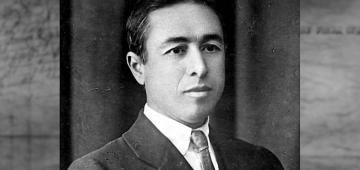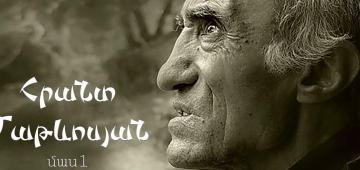 |
Aksel BakuntsWhat role did the film "Zangezur" play in the life of screenwriter Aksel Bakunts and what influence did it have on his fate? Novelist Hovhannes Yeranyan talks about the film "Zangezur" and Aksel Bakunts. |
 |
Hakob AnandyanHakob Manandyan was one of the great scientists who, by teaching at the Gevorgyan Theological Seminary, had turned that institution into the world's largest center of Armenology. Manandyan spoke more than ten languages, and taught history as well as various languages at the seminary. He wrote more than 150 scientific works in Armenian, Russian, and German. After the seminary was closed, when the first state university was opened, Manandyan became the head of the history department, and then was elected rector of the university. He was one of the founding academicians of the National Academy of Sciences. When the scientist was reminded of his great merit, he replied that all this should be considered a tribute of gratitude to the seminary, where he spent his best years. |
 |
Hrachya KocharHrachya Kochar was one of the most influential figures in Soviet Armenia in the 1950s and 1960s. The people called his summer residence in Lusakert the building of the Presidium of the Supreme Council. Here, the leaders of the republic discussed important issues for the country with the writer. Prose writer Hovhannes Yeranyan tells about the life path and legacy of the writer and controversial person Hrachya Kochar. |
 |
Miss GayaneThe next program in the series “In the Pavilion: Around Literature and Art” is dedicated to a unique mystery in the history of Armenian theater: a 19th-century theater actress who was famous as Miss Gayane. After gaining great fame, it is rumored that she is actually not a woman, but a man. She played for only one year, appeared on stage in only four roles, and left the theater. The program tries to answer the question: was that brilliant actress actually a woman and the victim of a conspiracy, or was she really a man? |
 |
Paruyr SevakAlmost half a century has passed since Paruyr Sevak's tragic car accident. To this day, suspicions have not disappeared that the car accident was an attempt to kill the writer. Novelist Hovhannes Yeranyan tries to answer the question: was the car accident an accident or a premeditated murder? |
 |
Ler KamsarThe next program in the series "In the Pavilion: Around Literature and Art" is dedicated to the famous satirist Ler Kamsar. Prose writer Hovhannes Yeranyan tries to answer the question of why his works and literary identity do not gain wide recognition among reading circles. |
 |
Hrant Matevosyan and Armenian theaterProse writer Hovhannes Yeranyan talks about the performances staged based on the works of Hrant Matevosyan. Why did the writer have a reserved attitude even towards those performances that were admired by the audience and critics? |
 |
Hrant Matevosyan and the Armenian movieThe first program of the series “In the Pavilion: About Literature and Art” is dedicated to the 90th anniversary of Hrant Matevosyan. Prose writer Hovhannes Yeranyan talks about the films shot based on the writer’s scripts, and tries to answer the question of why Matevosyan did not share the admiring opinions and attitudes of the public and critics even about successful films. |
 |
Grigor GhapantsyanJust three years after the closure of the Gevorgyan Seminary, the first state university of Armenia was opened. The vast majority of the teaching staff were former teachers of the seminary, and one of them was the linguist and Armenologist Grigor Ghapantsyan. In 1913, having rejected Nikoghayos Mar's offer to stay at the University of Saint Petersburg and work together, he returned to his homeland and entered the teaching staff of the Gevorgyan Theological Seminary. He immediately joined the group of Stepanos Malkhasyants, who was appointed Dean of the seminary, who was called upon to reform the educational programs of the seminary and write a new charter. He conducted his first serious studies at the seminary and published them in the journal "Ararat" of the Mother See. In 1918, with weapons in hand, he fought with Armenian clergy and scientists in the Battle of Sardarapat. He was the head of the Department of Linguistics of the newly opened State University, and the director of the Institute of Language of the newly established NAS. Some of the works written in Russian by the linguist who left behind a great scientific legacy have not been translated into Armenian to this day. |
 |
New Strategy for Education and Science: Part 214Together with education expert Serob Khachatryan, Hovhannes Yeranyan summarized the past academic year, discussed old and new issues of general education, and outlined the tasks for the new academic year. |
 |
New Strategy for Education and Science: Part 213Hovhannes Yeranyan discussed the past, present, and future of music education in Armenia with the artistic director of the Komitas Conservatory's opera studio, People's Artist, and renowned soprano Hasmik Papyan. They also spoke about the singer's implemented and upcoming programs at the opera studio. |
 |
New Strategy for Education and Science: Part 210Hovhannes Yeranyan discussed the results of reading competitions held for age groups with Anahit Yuzbashyan and Julia Vardanyan, co-founders of the Bvik Foundation. |
